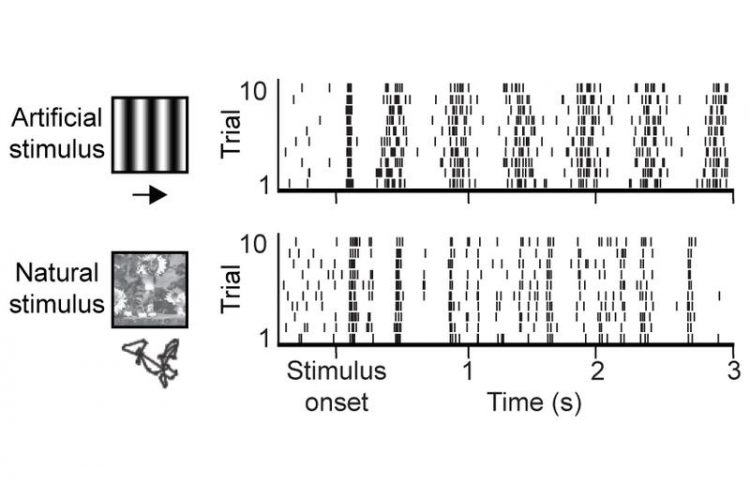How Neural Circuits Implement Natural Vision

Artificial and natural visual stimuli cause distinctly different neuronal dynamics in the visual cortex. Shown here are the responses of a neuron in the visual cortex to an artificial (top) and natural (bottom) visual stimulus.
At any given moment, the neuronal circuits in the brain receive and process sensory information that permits us to perceive and interact with the environment. Yet it remains unclear how the visual brain processes natural stimuli.
Together with an international team of researchers from the Centre Nationale de la Recherche Scientifique (CNRS) in Marseille, the CNRS in Gif-Sur-Yvette, and New York State University, neuroscientists Jens Kremkow and Ad Aertsen from the Bernstein Center Freiburg have developed a new computational model that simulates how neurons in the visual cortex process sensory stimuli.
This model may help neuroscientists to better understand how neuronal networks in the visual system process natural stimuli. The study has now been published in the journal Frontiers in Neural Circuits.
For decades, researchers have used simple artificial stimuli like moving bars to study the function of neuronal circuits in the visual system. In recent years, natural stimuli from the perception of daily life have taken on an increasingly important role in neuroscientific experiments.
“Studies revealed that the activity of neurons in the primary visual cortex was fundamentally different when they were exposed to artificial stimuli or to natural stimuli. While artificial stimuli evoked strong but temporally variable neuronal responses, neuronal responses to natural stimuli were weak but temporally precise. But we still did not understand why the neuronal networks change their activity dynamics in these cases,” says Kremkow.
With the help of their model, Kremkow and his colleagues have now provided a potential explanation: The distinctive neuronal responses may be the result of features commonly found in the pathways between the retina and the cortex. In particular, the precise interplay of excitatory and inhibitory synaptic inputs in the receptive fields of neurons in the visual cortex turned out to play a significant role.
The receptive fields of neurons in the visual cortex work similar to a camera sensor. They do not deliver sharp images of the environment but rather encode specific properties of the visual scene and contain excitatory and inhibitory areas. Artificial stimuli evoked temporally non-overlapping excitation and inhibition and strong neuronal responses.
When the neurons were exposed to natural stimuli, on the other hand, excitation and inhibition were temporally correlated, which explains the weak neuronal responses during natural viewing. In the opinion of Kremkow and Aertsen, this so-called push-and-pull mechanism could also be applied to the neuronal processing of natural stimuli in other sensory systems. Perhaps its malfunction could even be linked to perceptual impairments, in which case these results could lead to more questions for medical research.
Original publication:
Kremkow J, Perrinet LU, Monier C, Alonso J-M, Aertsen A, Fregnac Y, Masson GS (2016) Push-Pull Receptive Field Organization and Synaptic Depression: Mechanisms for Reliably Encoding Naturalistic Stimuli in V1. Frontiers in Neural Circuits 10:37; doi: 10.3389/fncir.2016.00037
Contact:
Dr. Jens Kremkow
Bernstein Center Freiburg
University of Freiburg
Phone: +49 (0)30/450 – 539826
E-mail: jens@kremkow.info
Michael Veit
Wissenschaftskommunikation
Bernstein Center Freiburg
Phone: +49 (0)761 / 203 – 9322
E-mail: michael.veit@bcf.uni-freiburg.de
https://www.pr.uni-freiburg.de/pm/2016/pm.2016-05-20.80-en?set_language=en
Media Contact
All latest news from the category: Life Sciences and Chemistry
Articles and reports from the Life Sciences and chemistry area deal with applied and basic research into modern biology, chemistry and human medicine.
Valuable information can be found on a range of life sciences fields including bacteriology, biochemistry, bionics, bioinformatics, biophysics, biotechnology, genetics, geobotany, human biology, marine biology, microbiology, molecular biology, cellular biology, zoology, bioinorganic chemistry, microchemistry and environmental chemistry.
Newest articles

Sea slugs inspire highly stretchable biomedical sensor
USC Viterbi School of Engineering researcher Hangbo Zhao presents findings on highly stretchable and customizable microneedles for application in fields including neuroscience, tissue engineering, and wearable bioelectronics. The revolution in…

Twisting and binding matter waves with photons in a cavity
Precisely measuring the energy states of individual atoms has been a historical challenge for physicists due to atomic recoil. When an atom interacts with a photon, the atom “recoils” in…

Nanotubes, nanoparticles, and antibodies detect tiny amounts of fentanyl
New sensor is six orders of magnitude more sensitive than the next best thing. A research team at Pitt led by Alexander Star, a chemistry professor in the Kenneth P. Dietrich…





















